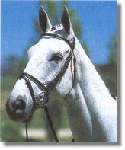
Carlyle White Lined Dressage Bridle
$79.95
| |
|
Seabiscuit - An American Legend - Book Review
Jim Gorman
|
Author: Laura Hillenbrand
Random House; ISBN 0-375-50291-2; 399 pages; $24.95 US; Hardcover.
Also available from Random House AudioBooks.
If you love horses, just to be around them and know them, you will love this book.
If you love to ride horses, or train them, or work with them, or raise them, or watch them develop and grow to the limit of their potential, you will love this book. This is a book for horse people, whether young, old, male, female, a rider, or simply an onlooker.
It’s a love story between an owner, a jockey, a trainer, and one of the gutsiest racehorses in U.S. history – Seabiscuit. It is the story of triumph over adversity, capturing the spirit of the underdog. Just the mention of his name could send a thunderbolt of shock through thousands of onlookers as he won at California’s Santa Anita or Chicago’s Arlington Park or New York’s Belmont. Or he could bring his owner’s wife to tears as he crashed to the ground in a near-fatal pileup in the stretch.
Start saving your money for Christmas. You are going to have to buy a number of copies of this book for friends and family when gift-giving time rolls around.
Seabiscuit was bought in the sultry summer of 1936 for a bargain basement price of $8,000.
“I just fell in love with him,” said Charles S. Howard, and he gave the runty, dirty bay with crooked legs to his wife.
This was a horse that was destined to beat War Admiral, win the Santa Anita Handicap, and win a world record $437,730.
When his lead strap passed hands from world famous trainer Sunny Jim Fitzsimmons to Tom Smith, the crossing of stars in heaven was just beginning. Smith said at the time, “He looked right down his nose at me. I knew his quality was in his heart.”
Smith, a taciturn westerner from the open cowboy range, had broken broncs as a kid with Indians as his audience. For a wage of $60 a month, Smith slept and ate in horse stalls while he struggled to be a farrier to 54 horses.
But Smith had developed an almost mystical communion with horses. He knew their minds and how to sway them. He knew their bodies and his hands were a tonic for their pain. He spoke infrequently, perhaps because he was listening so hard. “It’s easy to talk to a horse,” Smith said, “if you understand his language.”
“Horses stay the same from the day they are born until the day they die. They only change by the way people treat them,” Smith said.
Smith treated them with intensity and respect while applying almost medicine-man treatments to their ills. He had developed “magic salves” as his jealous and curious competitors would call them, which to this day, no one knows quite what the ingredients were.
He would spend hours with Seabiscuit, massaging his legs and talking to him in an almost inaudible voice, calling him “son.” He would let the horse out of his stall without a halter, guiding him with only a light, gentle touch.
Smith understood when the horse liked to eat and sleep, and when he liked to face down a challenger – eyeball to eyeball.
The trainer approached each of his horses as a distinct individual, and followed his own lights and experience to care for it. Though Howard was a highly successful, hands-on, get-it-done type businessman, he knew well enough to let Smith alone.
Enter jockey Red Pollard. Elegant, tautly muscled, no money, no home, sleeping in stalls, he carried with him a saddle, a rosary, and his books by Shakespeare and Robert Service. “A caged bird,” as his son was later to call him, he was on a headlong rush into danger and uncertainty. At fifteen, he was alone and penniless in Butte, Montana, beginning his career. This is the jockey who grew into a partnership with Howard and Smith, and became world famous as the rider who would take Seabiscuit to racing immortality.
Pollard grew to love and become one with this thoroughbred who looked more like a tough little cowhorse with his straggly tail and “baseball glove” knees that didn’t straighten all the way. Pollard and the horse learned to understand each other and by the time Seabiscuit won the 50th start of his racing career, he finally understood the game.
Seabiscuit learned he could trust Smith and Pollard, and when he was no longer coerced, his instincts bubbled. Those unfamiliar with horses might scoff at the notion of equine pride and understanding, but the resultant behavior is unmistakable.
Howard, Smith, Pollard, and Seabiscuit – a most unlikely combination – were a winning team.
We are a strange lot, we horse people. We run a horse until he is drenched in sweat, then walk him for an hour to cool him out. We lay a crop to his back to discipline him, and then we stroke and talk to him so low that only he can understand the calming words. We get up on him and push him to do the same things over and over until he knows what is expected at the flick of a finger. We know what it is to understand and be understood, to love and be loved by an animal with 10,000 years of noble heritage behind him. We are a strange lot, we horse people, but we are lucky to have found our calling in life, just as these four disparate beings came together to find theirs. Read the book and see for yourself.
|
|
|
|
|
|
|



